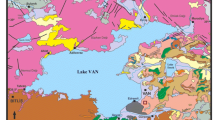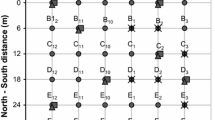Abstract
The Menard pressuremeter modulus (Em), limit pressure (PL), shear modulus (G) and subgrade reaction modulus (Ks) can be obtained by using the pressuremeter test, and are needed as parameters to obtain the geotechnical parameters for foundation design and to determine the ultimate bearing capacity in engineering projects. In this article, correlations of Menard pressuremeter tests (PMTs) with standard penetration tests (SPTs) and cone penetration tests (CPTs) are obtained as a consequence of the extensive geotechnical investigation performed in alluvial soils of the Tabriz Metro Line 2, Iran. A total of 85 boreholes with depths of 20–40 m were drilled, and the three mentioned tests were performed at varying depths. Correlations were carried out separately for silty clay (CL), clayey silt (ML) and silty sand (SM) soils, respectively. Statistical correlations between Em, PL, G and Ks from the PMTs were performed with the corrected SPT numbers (Ncor). In addition, relationships between the limit pressure (PL) from PMTs and cone resistance (qc) from CPTs were determined for fine-grained and coarse-grained soils. Attempts were also made to correlate PL with Em, and Em/PL ratios. The results of this investigation indicated acceptable experimental regression relationships between these parameters. The comparisons between the measured and the predicted values of Em and PL obtained herein with those estimated from other equations that have been proposed by other researchers revealed that they are compatible. It can be concluded that the proposed relationships for fine-grained and coarse-grained soils can be utilized to determine Em, PL, G and Ks from the Ncor values and PL from the qc values.




















Similar content being viewed by others
Abbreviations
- TML2:
-
Tabriz Metro Line 2
- USCS:
-
Unified Soil Classification System
- CL:
-
Silty clay
- ML:
-
Clayey silt
- SM:
-
Silty sand
- LL:
-
Liquid limit
- PI:
-
Plasticity index
- SPT:
-
Standard penetration test
- CPT:
-
Cone penetration test
- PMT:
-
Menard pressuremeter test
- Ncor :
-
Corrected SPT number
- N60 :
-
Corrected SPT for an efficiency of 60%
- Em :
-
Menard pressuremeter modulus
- ν :
-
Poisson’s ratio
- V 0 :
-
Volume of the uninflated probe at the ground surface
- ΔP :
-
Corrected pressure increase in the center part of the straight line portion of the pressure–volume curve
- ΔV :
-
Corrected volume increase in the center part of the straight line portion of the pressure–volume curve, corresponding to a pressure increase of ΔP
- V m :
-
Corrected volume reading in the center portion of the ΔV volume increase
- G:
-
Shear modulus
- PL :
-
Limit pressure
- Ks :
-
Subgrade reaction modulus
- α:
-
A coefficient in determining Ks from PMT
- R:
-
Pile radius
- R0 :
-
Initial pile radius
- CB :
-
Borehole diameter correction
- CS :
-
Sampler correction
- CR :
-
Rod length correction
- CN :
-
Effective overburden stress correction
- \( {\sigma}_V^{\prime } \) :
-
In-situ vertical effective stress
- qc :
-
Cone tip resistance in CPT
- qt :
-
Total cone resistance in CPT
- fs :
-
Sleeve friction in CPT
- Rf :
-
Friction ratio in CPT
- R2 :
-
Regression coefficient
- μ:
-
Mean
- σ:
-
Standard deviation
References
Agan C (2014) Determination of the deformation modulus of dispersible-intercalated-jointed cherts using the Menard pressuremeter test. Int J Rock Mech Min Sci 65:20–28
Alavi AH, Gandomi AH, Chahkandi-Nejad H, Mollahasani A, Rashed A (2013) Design equations for prediction of pressuremeter soil deformation moduli utilizing expression programming systems. Neural Comput and Applic 23:1771–1786
Ampadu SIK, Ayeh FF, Boadu F (2018) Deriving SPT N-values from DCP test results: the case of foundation design in a tropical environment. Geotech Geol Eng 36(4):2517–2531
Anbazhagan P, Kumar A, Sitharam TG (2013) Seismic site classification and correlation between standard penetration test N value and shear wave velocity for Lucknow city in indo-Gangetic basin. Pure Appl Geophys 170:299–318
Anwar MB (2016) Correlation between PMT and SPT results for calcareous soil. HBRC Journal
ASTM D3441 (2016) Standard test method for mechanical penetration tests (CPT) of soils, American Society for Testing and Materials. Philadelphia, USA
ASTM D4719 (2016) Standard test method for pressuremeter testing in soils. In: American Society for Testing and Materials. Philadelphia, USA
ASTM D1586 (2011) Standard test method for standard penetration (SPT) and Split-barrel sampling of soils. In: American Society for Testing and Materials. Philadelphia, USA
Bowles JE (1988) Foundation analysis and design. McGraw-Hill, New York
Bozbey I, Togrol E (2010) Correlation of standard penetration test and pressuremeter data: a case study from Istanbul, Turkey. Bull Eng Geol Environ 69(4):505–515
Bureau of Technical Affairs and Standards of Iran (2002) Pressuremeter test: Instruction for test and application for foundation design, No. 223, Management and planning organization of Iran (in Persian)
Cheshomi A, Ghodrati M (2015) Estimating Menard pressuremeter modulus and limit pressure from SPT in silty sand and silty clay soils. A case study in Mashhad, Iran. Geomech Geoeng 10(3):194–202
Clarke BG (1995) Pressuremeter in geotechnical design. Blackie, London
Esfehanizadeh M, Nabizadeh F, Yazarloo R (2015) Correlation between standard penetration (NSPT) and shear wave velocity (vs) for young coastal sands of the Caspian Sea, Arab J. Geosci 8:7333–7341
Firuzi M (2009) Study of the geological characteristics of soils along Tabriz Line2 subway using pressuremeter tests, MSc Thesis, Isfahan University, Isfahan, Iran (in Persian)
Ghobadi MH, Firuzi M, Asghari-Kaljahi E (2016) Relationships between geological formations and groundwater chemistry and their effects on the concrete lining of tunnels (case study: Tabriz Metro Line 2). Environ Earth Sci 75(12):987
Kayabası A (2011) Prediction of pressuremeter modulus and limit pressure of clayey soils by simple and non-linear multiple regression techniques: a case study from Mersin. Turkey, Environ Earth Sci 66:2171–2183
Liao SS, Whitman RV (1986) Overburden correction factors for SPT in sand. J Geotech Eng 112(3):373–377
Mohammadi SD, Firuzi M, Asghari-Kaljahi E (2016) Geological-geotechnical risk in the use of EPB-TBM, case study: Tabriz metro. Iran Bull Eng Geol Environ 75(4):1571–1583
Murthy S (2008) Geotechnical engineering: principles and practices of soil mechanics, 2nd edn. CRC, UK
Naseem A, Jamil SM (2016) Development correlation between standard penetration test and pressuremeter test for clayey sand and sandy soil. Soil Mech Found Eng 53(2):98–102
Rashed A, Bazaz JB, Alavi AH (2012) Nonlinear modeling of soil deformation modulus through LGP-based interpretation of pressuremeter test results. Eng Appl Artif Intell 25(7):1437–1449
Robertson PK, Campanella RG, Wightman A (1983) SPT-CPT correlations. J Geotech Eng 109(11):1449–1459
Skempton AW (1986) Standard penetration test procedures and the effects in sands of overburden pressure, relative density, particle size, ageing and over consolidation. Geotechnique 36(3):425–447
Smith GN (1986) Probability and statistics in civil engineering. Collins, London
Soleimanbeigi A (2013) Undrained shear strength of normally consolidated and over consolidated clays from pressuremeter tests: a case study. Geotech Geol Eng 31(5):1511–1524
Yagiz S, Akyol E, Sen G (2008) Relationship between the standard penetration test and the pressuremeter test on sandy silty clays: a case study from Denizli. Bull Eng Geol Environ 67:405–410
Acknowledgments
The authors are grateful to the Tabriz Urban Railway Organization (TURO) and Pazhoohesh Omran Rahvar (POR) Consulting Engineers Company for their collaboration in preparing the site investigation and test data.
Author information
Authors and Affiliations
Corresponding author
Rights and permissions
About this article
Cite this article
Firuzi, M., Asghari-Kaljahi, E. & Akgün, H. Correlations of SPT, CPT and pressuremeter test data in alluvial soils. Case study: Tabriz Metro Line 2, Iran. Bull Eng Geol Environ 78, 5067–5086 (2019). https://doi.org/10.1007/s10064-018-01456-0
Received:
Accepted:
Published:
Issue Date:
DOI: https://doi.org/10.1007/s10064-018-01456-0




